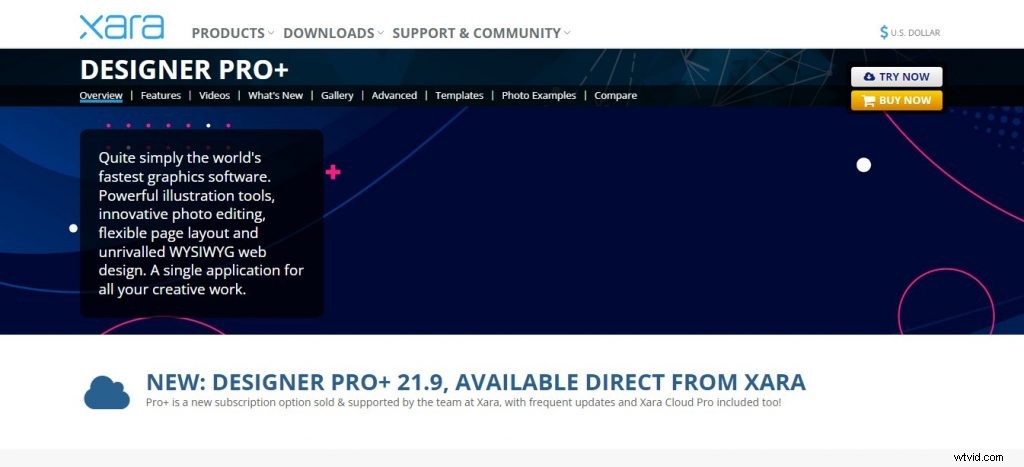Projektowanie graficzne to coś więcej niż tylko sprawienie, by coś wyglądało dobrze — to także sprawienie, by coś działało. Wielu grafików ma za zadanie tworzenie projektów, które nie tylko świetnie wyglądają, ale także pomagają sprzedać produkt lub usługę lub przekazać ważną wiadomość.
Ale zanim staniesz się kolejnym kultowym grafikiem, musisz wybrać odpowiednie oprogramowanie do swoich potrzeb. Istnieje wiele platform do projektowania graficznego, a każda z nich ma swoje mocne i słabe strony.
Jeśli szukasz prostego programu do tworzenia kilku logo lub grafiki na komputerze Mac lub PC, bezpłatne narzędzie, takie jak Canva, może być dla Ciebie idealne. Ale jeśli pracujesz nad dużym projektem wideo, który wymaga wysokiej jakości obrazów i zaawansowanych efektów specjalnych, Adobe Premier Pro może być wart zainwestowania.
Aby tworzyć projekty, grafikę i ilustracje, możesz użyć oprogramowania wektorowego, takiego jak Adobe Illustrator, aby osiągnąć najlepsze wyniki. W tym przewodniku dokonaliśmy przeglądu najlepszych rozwiązań oprogramowania do projektowania graficznego dostępnych na rynku.
Dołączone przez nas programy to standardowe w branży narzędzia, których można używać do tworzenia pięknych projektów, logo i ilustracji. Zrobiliśmy dla Ciebie wszystkie badania i stworzyliśmy listę najlepszych opcji oprogramowania do projektowania graficznego w 2022 roku.
Dołączyliśmy również przewodnik zakupu, dzięki któremu możesz zrozumieć, jakie funkcje i funkcje oferują te programy.
Najlepsze oprogramowanie do projektowania graficznego – wprowadzenie
Najlepsze oprogramowanie do projektowania graficznego to takie, które spełnia Twoje potrzeby projektowe. To powiedziawszy, oto kilka typowych scenariuszy:jesteś profesjonalnym grafikiem, pracujesz dla agencji lub jako freelancer dla klientów i potrzebujesz wszechstronnego zestawu narzędzi do tworzenia wysokiej jakości treści wizualnych i prezentowania ich klientom.
Jesteś grafikiem amatorem, który szuka czegoś, co pomoże Ci wyrazić swoje kreatywne pomysły na papierze. Jesteś właścicielem małej firmy, który musi stworzyć wizualną markę dla swojej firmy, w tym logo, banery w mediach społecznościowych i grafikę internetową.
Niezależnie od przypadku, potrzebujesz czegoś, co jest łatwe w użyciu i ma wystarczająco dużo funkcji, aby spełnić Twoje potrzeby. Wybór najlepszego oprogramowania do projektowania graficznego dla Twoich potrzeb może wydawać się zniechęcający.
Do wyboru są setki produktów, a większość z nich ma nakładające się funkcje. Dobrą wiadomością jest to, że jest teraz więcej darmowych narzędzi do projektowania graficznego niż kiedykolwiek wcześniej. Więc jeśli dopiero zaczynasz i nie masz budżetu na inwestycje w oprogramowanie, możesz zacząć korzystać z tych gratisów.
Jeśli jesteś doświadczonym profesjonalistą, przekonasz się, że wiele płatnych programów ma bezpłatne wersje próbne i/lub opcje subskrypcji, więc możesz wypróbować przed zakupem — lub zapłacić na bieżąco.
Jakie jest najlepsze oprogramowanie do projektowania graficznego?
Jakie jest najlepsze oprogramowanie do projektowania graficznego? Odpowiedź oczywiście zależy od tego, czego szukasz. Chcesz zaprojektować plakat w swojej przeglądarce? Stworzyć animację z grafiką wektorową? Co powiesz na zaprojektowanie logo lub pracę z modelami 3D?
Jeśli jesteś zainteresowany karierą w projektowaniu graficznym, powinieneś poważnie podejść do nauki i opanowania podstaw teorii i praktyki projektowania graficznego, zrozumieć cel tego, co projektujesz i rozwijać swoje kreatywne rozwiązywanie problemów umiejętności.
Aby to wszystko zrobić — i wiele, wiele więcej — musisz znaleźć odpowiednie oprogramowanie do swoich konkretnych potrzeb. Jeśli dopiero zaczynasz jako projektant i nie jesteś pewien, jak chcesz się specjalizować (lub nawet czy w ogóle chcesz się specjalizować), nie martw się.
Mamy wiele porad, jak zacząć projektowanie graficzne.
1. Adobe Photoshop
Adobe Photoshop to edytor grafiki rastrowej opracowany i opublikowany przez firmę Adobe Systems dla systemów macOS i Windows. Photoshop został stworzony w 1988 roku przez Thomasa i Johna Knollów.
Od tego czasu stał się de facto standardem branżowym w edycji grafiki rastrowej, tak że słowo „photoshop” stało się czasownikiem, jak w „do Photoshopa obraz”, „photoshopping” i „photoshop Competition”, chociaż Adobe odradza takie użycie . Może edytować i komponować obrazy rastrowe na wielu warstwach i obsługuje maski, komponowanie alfa i kilka modeli kolorów, w tym RGB, CMYK, CIELAB, kolor dodatkowy i duotone. Photoshop ma szerokie wsparcie dla formatów plików graficznych, ale używa również własnych formatów plików PSD i PSB, które obsługują wszystkie wyżej wymienione funkcje.
Oprócz grafiki rastrowej ma ograniczone możliwości edycji lub renderowania tekstu, grafiki wektorowej (szczególnie poprzez ścieżkę przycinającą), grafiki 3D i wideo. Zestaw funkcji Photoshopa można rozszerzyć za pomocą wtyczek; programy opracowane i dystrybuowane niezależnie od Photoshopa, które mogą działać w nim i oferują nowe lub ulepszone funkcje.
Obie wersje programu Photoshop były objęte licencją wieczystą bez subskrypcji do 1 grudnia 2013 r. wraz z wprowadzeniem brandingu Creative Cloud, dzięki czemu obie wersje są teraz dostępne
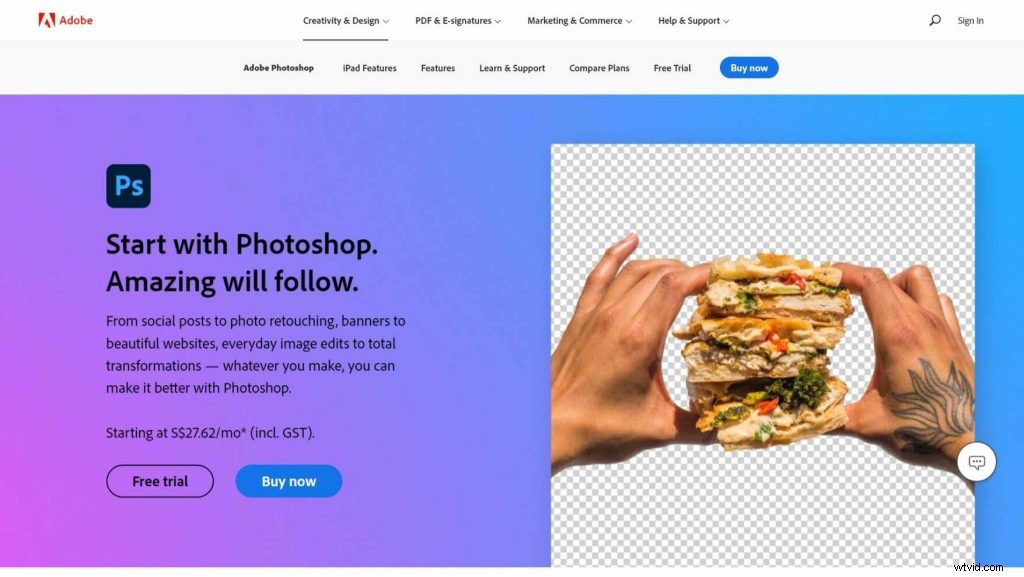
Funkcje
Adobe Photoshop to jedno ze starszych i najbardziej znanych dostępnych narzędzi do edycji zdjęć. Dzięki zaawansowanym funkcjom i przyjaznemu dla użytkownika interfejsowi stało się branżowym standardem tworzenia, edytowania i manipulowania obrazami.
Oto niektóre z funkcji, które sprawiają, że Adobe Photoshop to doskonały wybór do edycji zdjęć:Możliwości edycji. Możesz przycinać, zmieniać rozmiar, dostosowywać kolor i jasność, stosować filtry i efekty oraz nie tylko.
Zgodność. Photoshop jest kompatybilny z wieloma różnymi typami plików i formatami plików, w tym .psd (dokument Photoshop), .pdf (Portable Document Format), .png (Portable Network Graphics), .gif (Graphic Interchange Format) i nie tylko.
Kompatybilność z innymi programami. Adobe Photoshop zawiera wiele programów towarzyszących, w tym Lightroom, Illustrator, Bridge, InDesign, Premiere Pro i wiele innych, które umożliwiają tworzenie oszałamiających zdjęć, a także innych rodzajów grafiki.
Zalety
Profesjonaliści Photoshopa to ludzie, którzy świetnie radzą sobie z używaniem Adobe Photoshop. Robią takie rzeczy: Mają supermoce, takie jak możliwość zmiany każdego w kota… czy krowę? Szczerze mówiąc, nie wiem, kto może śledzić wszystkie zwierzęta, w które mogą zmienić ludzi?
2. Adobe InDesign
Adobe InDesign to aplikacja do publikowania i składu tekstu komputerowego wyprodukowana przez firmę Adobe Systems. Może być używany do tworzenia prac, takich jak plakaty, ulotki, broszury, czasopisma, gazety i książki.
InDesign może również publikować treści odpowiednie dla tabletów w połączeniu z pakietem Adobe Digital Publishing Suite. Głównymi użytkownikami są graficy i artyści produkcyjni, tworzący i opracowujący publikacje periodyczne, plakaty i media drukowane.
Obsługuje również eksport do formatów EPUB i SWF w celu tworzenia e-booków i publikacji cyfrowych, w tym czasopism cyfrowych, oraz treści nadających się do użytku na komputerach typu tablet. Ponadto program InDesign obsługuje XML, arkusze stylów i inne znaczniki kodowania, dzięki czemu nadaje się do eksportowania oznakowanej zawartości tekstowej do wykorzystania w innych formatach cyfrowych i online.
Procesor tekstu Adobe InCopy używa tego samego mechanizmu formatowania co InDesign. Program InDesign był wcześniej dostępny jako część pakietu Creative Suite. Od wersji CS5 (wydanej w kwietniu 2010 r.) nie jest już dostępna „dołączona” wersja; jest sprzedawany tylko jako samodzielny produkt lub jako część jednej z dwóch wersji Creative Cloud (patrz poniżej).
Jednak w połowie stycznia 2017 r. firma Adobe ogłosiła, że wznowi oferowanie pakietów CS6.[1] InDesign CC 2018 to najnowsza wersja programu InDesign CC
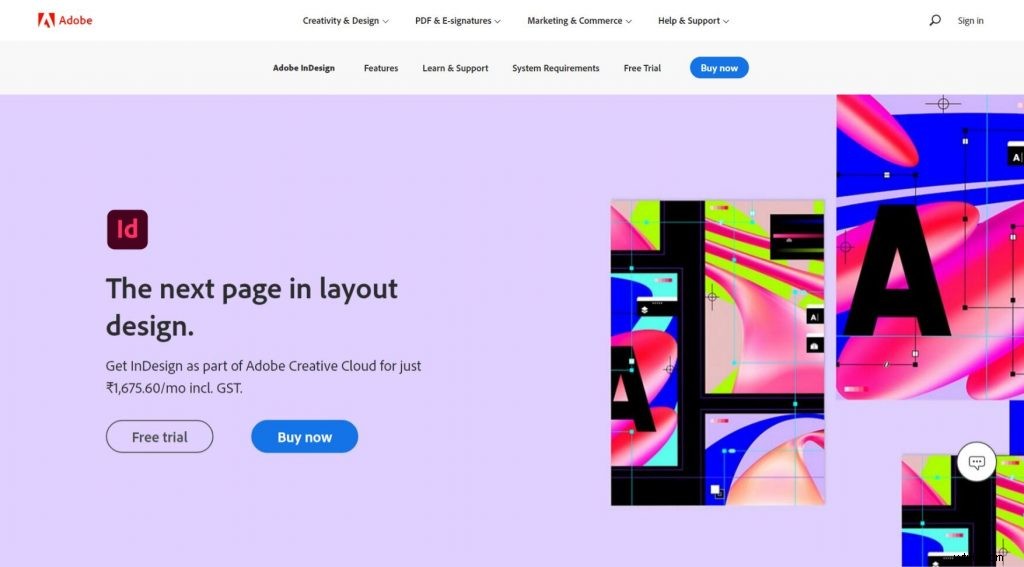
Funkcje
Adobe InDesign to aplikacja do publikowania i składu tekstu komputerowego wyprodukowana przez firmę Adobe Systems. Może być używany do tworzenia prac, takich jak plakaty, ulotki, broszury, czasopisma, gazety, prezentacje, książki i e-booki.
InDesign może również publikować treści odpowiednie dla tabletów w połączeniu z pakietem Adobe Digital Publishing Suite. Głównymi użytkownikami są graficy i artyści produkcyjni, tworzący i opracowujący publikacje periodyczne, plakaty i media drukowane.
Obsługuje również eksport do formatów EPUB i SWF w celu tworzenia e-booków i publikacji cyfrowych, w tym czasopism cyfrowych, oraz treści odpowiednich do konsumpcji na tabletach.
Ponadto program InDesign obsługuje XML, arkusze stylów i inne znaczniki kodowania, dzięki czemu nadaje się do eksportowania oznakowanej zawartości tekstowej do wykorzystania w innych formatach cyfrowych i online. Obszar roboczy Adobe InDesign składa się z pięciu obszarów roboczych:
Podstawy:przeglądaj menu i paski narzędzi w jednej kolumnie; Zaawansowane:przeglądanie menu w dwóch kolumnach; Książka:łatwiej zarządzaj długimi dokumentami; Sieć:tworzenie dokumentów internetowych; Druk:przygotowanie plików do druku;
Zalety
Zalety Adobe InDesign InDesign to standardowa w branży aplikacja do publikowania, która umożliwia projektowanie i publikowanie wysokiej jakości dokumentów w pełnym spektrum mediów cyfrowych i drukowanych. Program InDesign ma wszystko, czego potrzebujesz do tworzenia plakatów, książek, czasopism cyfrowych, e-booków, interaktywnych plików PDF i nie tylko. Projektuj szybciej i mądrzej dzięki narzędziom stworzonym do współpracy.
Dodawaj efekty, zarządzaj stylami i edytuj poszczególne znaki, aby tworzyć projekty typograficzne, które doskonale wyrażają Twoje wiadomości. Uzyskaj dostęp do szablonów InDesign Korzystaj z Adobe Stock z programem InDesign i znajdź idealny zasób, aby ulepszyć swój projekt.
Szybko przeszukuj Photoshopa w aplikacji lub w witrynie Adobe Stock, aby wstawić obrazy bez tantiem za pomocą jednego kliknięcia. Twórz eleganckie i wciągające strony do druku, tabletów i innych ekranów.
Wyświetlaj podgląd projektów podczas ich tworzenia dzięki nowej funkcji płynnego układu siatki, która automatycznie dostosowuje zawartość podczas pracy.
3. Pakiet graficzny CorelDraw
CorelDRAW Graphics Suite 2019 to wiodące oprogramowanie do projektowania graficznego, z którego korzystają miliony profesjonalistów, właścicieli małych firm i entuzjastów projektowania na całym świecie.
Oferuje bezproblemowe projektowanie grafiki, układu, ilustracji, edycji zdjęć, śledzenia, obrazów internetowych, projektów drukowanych, sztuki, typografii i nie tylko. Projektuj z pewnością i osiągaj oszałamiające rezultaty.
Od koncepcji po produkcję, ten kompletny pakiet oprogramowania do projektowania graficznego pomaga tworzyć profesjonalne projekty szybciej niż kiedykolwiek wcześniej. Pakiet CorelDRAW Graphics Suite na każdym projekcie lub poziomie umiejętności ułatwia rozpoczęcie pracy dzięki uznanym w branży szablonom i materiałom edukacyjnym.
Znajdź idealne zdjęcia i ilustracje do swoich projektów, korzystając z wbudowanej wymiany treści z Fotolia lub własną siecią serwisów społecznościowych. Pracuj szybko dzięki usprawnionemu interfejsowi, który koncentruje się na wyglądzie, który chcesz osiągnąć, bez żadnych dodatkowych funkcji, które staną Ci na drodze.
Dzięki zwiększonej szybkości, dokładniejszej kontroli kolorów, znakomitym narzędziom do ilustracji wektorowych i nowym funkcjom sieciowym jest to pozycja obowiązkowa dla każdego projektanta. Pakiet CorelDRAW Graphics Suite 2019 zawiera zbiór siedmiu zaawansowanych aplikacji, które zaspokoją wszystkie rodzaje kreatywności.
Niezależnie od tego, czy pasjonujesz się pikselami, masz obsesję na punkcie wydruków, czy zakochasz się w układzie, możesz to wszystko zrobić w jednym, płynnie zintegrowanym przepływie pracy. CorelDRAW X
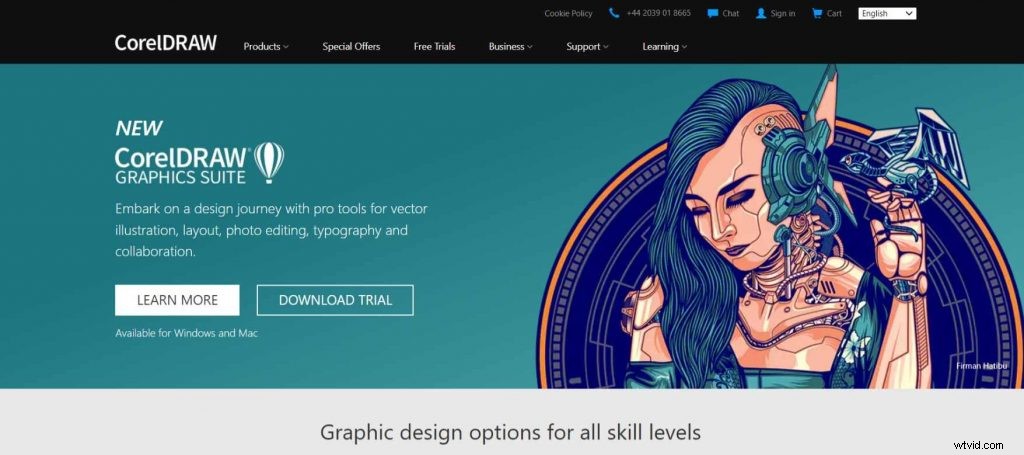
Funkcje
Funkcje pakietu CorelDraw Graphics Suite Nowe funkcje pakietu CorelDRAW Graphics Suite 2019 obejmują:Projektuj z większą precyzją i kontrolą na monitorach o wysokiej rozdzielczości dzięki nowemu, w pełni konfigurowalnemu interfejsowi. Ciesz się płynnym projektowaniem z szybszym powiększaniem, lepszym wyborem obiektów i inteligentniejszą edycją węzłów.
Wbudowane szablony ułatwiają rozpoczęcie pracy. Nowa uproszczona aplikacja internetowa CorelDRAW.app umożliwia dostęp do pracy, gdziekolwiek jesteś. Narzędzie LiveSketch umożliwia szkicowanie i projektowanie w locie.
Zaawansowane przestrzenie robocze ułatwiają przełączanie między różnymi układami w zależności od typu projektu, nad którym pracujesz. Odkryj szereg nowych aplikacji we wbudowanej przestrzeni roboczej ConceptShare do współpracy — w tym przechwytywanie ekranu pulpitu, generator kodów QR i skaner kodów QR.
Zalety
CorelDraw Graphics Suite X7 to program do edycji grafiki, który umożliwia tworzenie i edycję obrazów wektorowych. Jedną z zalet używania obrazów wektorowych w przeciwieństwie do obrazów rastrowych jest to, że można je skalować w górę lub w dół bez utraty rozdzielczości.
Program zawiera szereg funkcji ułatwiających tworzenie i edycję projektów, w tym nowy menedżer czcionek i zaawansowaną obsługę rysika. Zalety pakietu CorelDraw Graphics Suite Zalety pakietu CorelDraw Graphics Suite
Funkcjonalność:
Obsługuje wiele formatów multimediów cyfrowych, takich jak modele 3D i cliparty, które można włączyć do projektów projektowych. Zawiera narzędzia do cyfrowego malowania i rysowania, które są szczególnie przydatne dla grafików.
Ma konfigurowalne układy stron, dzięki czemu możesz mieć większą kontrolę nad projektem swoich dokumentów.
Kompatybilność:
Obsługuje wiele różnych formatów plików, które można importować lub eksportować z programu. Ułatwia to udostępnianie plików między różnymi systemami.
Na przykład, jeśli pracujesz nad projektem z kimś, kto używa innego rodzaju oprogramowania, takiego jak Adobe Illustrator, nadal będziesz mógł udostępniać mu pliki, ponieważ CorelDraw obsługuje format AI. Dodatkowo, jeśli coś stanie się z Twoim komputerem lub systemem operacyjnym, nieoczekiwanie ulegnie awarii z powodu
4. Adobe Illustrator
Adobe Illustrator to edytor grafiki wektorowej opracowany i sprzedawany przez firmę Adobe Inc. Pierwotnie zaprojektowany dla Apple Macintosh, rozwój programu Adobe Illustrator rozpoczął się w 1985 roku. Wraz z Creative Cloud (przejście firmy Adobe na miesięczną lub roczną subskrypcję przez Internet), Illustrator CC został wydany. Najnowsza wersja, Illustrator CC 2017, to dwudziesta pierwsza generacja w linii produktów.
Adobe Illustrator został oceniony jako najlepszy program do edycji grafiki wektorowej w 2018 roku przez PC Magazine i znalazł się na ich liście 100 najlepszych produktów wszechczasów.[9][10]
Pierwsza wersja programu Illustrator dla systemu Windows, wersja 2.0, została wydana na początku 1989 roku i trafiła na klapę. Wersja 4 była jednak pierwszą wersją programu Illustrator obsługującą edycję w trybie podglądu.[11] Od tego czasu wprowadzono różne narzędzia, które pomagają tworzyć różnorodne projekty i efekty w programie Adobe Illustrator.
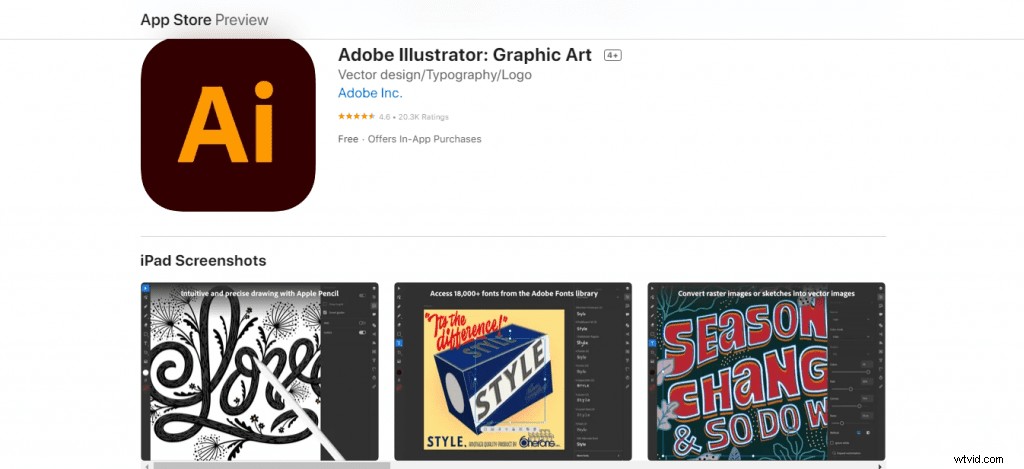
Funkcje
Pakiet oprogramowania Adobe Illustrator to szeroko stosowany program do edycji grafiki wektorowej. Jest częścią pakietu Adobe Creative Suite i oferuje wiele takich samych funkcji dostępnych w pozostałych programach Adobe, w tym Photoshop i InDesign.
Przegląd funkcji programu Adobe Illustrator Podstawowe narzędzia Program Illustrator ma wiele wbudowanych narzędzi, które umożliwiają tworzenie, manipulowanie i edycję grafiki wektorowej. Narzędzia te obejmują podstawowe kształty i linie, pola tekstowe i wypełnienia gradientowe.
Program umożliwia również importowanie do projektów grafiki rastrowej opartej na pikselach. Efekt Ta funkcja pozwala użytkownikom na zastosowanie do obiektu efektów ze świata rzeczywistego, takich jak poświata zewnętrzna, cień lub wtapianie. Użytkownicy mogą również tworzyć własne efekty niestandardowe za pomocą interfejsu graficznego programu Illustrator.
Efekt można następnie zapisać jako styl efektu, który można później zastosować do dowolnego innego obiektu. Warstwy Warstwy to sposób organizowania rysunku poprzez układanie obiektów jeden na drugim, jak kartki papieru. Obiekty narysowane na niższych warstwach pojawią się pod obiektami na wyższych warstwach; jednak nadal możesz wybierać obiekty, które są zasłonięte przez inne obiekty, po prostu zaznaczając je w panelu Warstwy.
Wyrównaj i rozłóż panel
Panel Wyrównaj i rozłóż umożliwia wyrównanie wielu
Zalety
Istnieje wiele korzyści z używania programu Adobe Illustrator w porównaniu z jego darmowymi odpowiednikami. Oto kilka zalet:Adobe Illustrator jest znacznie potężniejszy i bogatszy w funkcje niż darmowe programy.
Zawiera wiele kreatywnych usług i aplikacji w chmurze, których możesz używać jako uzupełnienie swojej pracy. Masz dostęp do tysięcy wtyczek, rozszerzeń i szablonów, dzięki którym możesz zaoszczędzić dużo czasu.
W tym samouczku pokażę Ci, jak najlepiej wykorzystać program Adobe Illustrator, używając kilku naprawdę fajnych sztuczek, które pomogą Ci przenieść Twoje umiejętności na wyższy poziom.
5. Inkscape
Inkscape to edytor grafiki wektorowej o otwartym kodzie źródłowym, podobny do Adobe Illustrator, Corel Draw, Freehand lub Xara X. To, co wyróżnia Inkscape, to użycie Scalable Vector Graphics (SVG), otwartego standardu W3C opartego na XML, jako formatu natywnego .
Można importować i eksportować inne formaty. Inkscape reprezentuje standard W3C w potężny i pragmatyczny sposób. Główną motywacją Inkscape jest zapewnienie społeczności Open Source narzędzia do rysowania w pełni zgodnego z W3C XML, SVG i CSS2. Dodatkowo wybierz plik wyjściowy PDF z motywem PostScript, aby ułatwić udostępnianie innym użytkownikom.
Inkscape obsługuje wiele zaawansowanych funkcji SVG (markery, klony, alpha blending, itp.) i bardzo starannie projektuje usprawniony interfejs. Bardzo łatwo jest edytować węzły, wykonywać złożone operacje na ścieżkach, śledzić mapy bitowe i wiele więcej. Naszym celem jest również utrzymanie dobrze prosperującej społeczności użytkowników i programistów, korzystając z otwartego, zorientowanego na społeczność rozwoju.
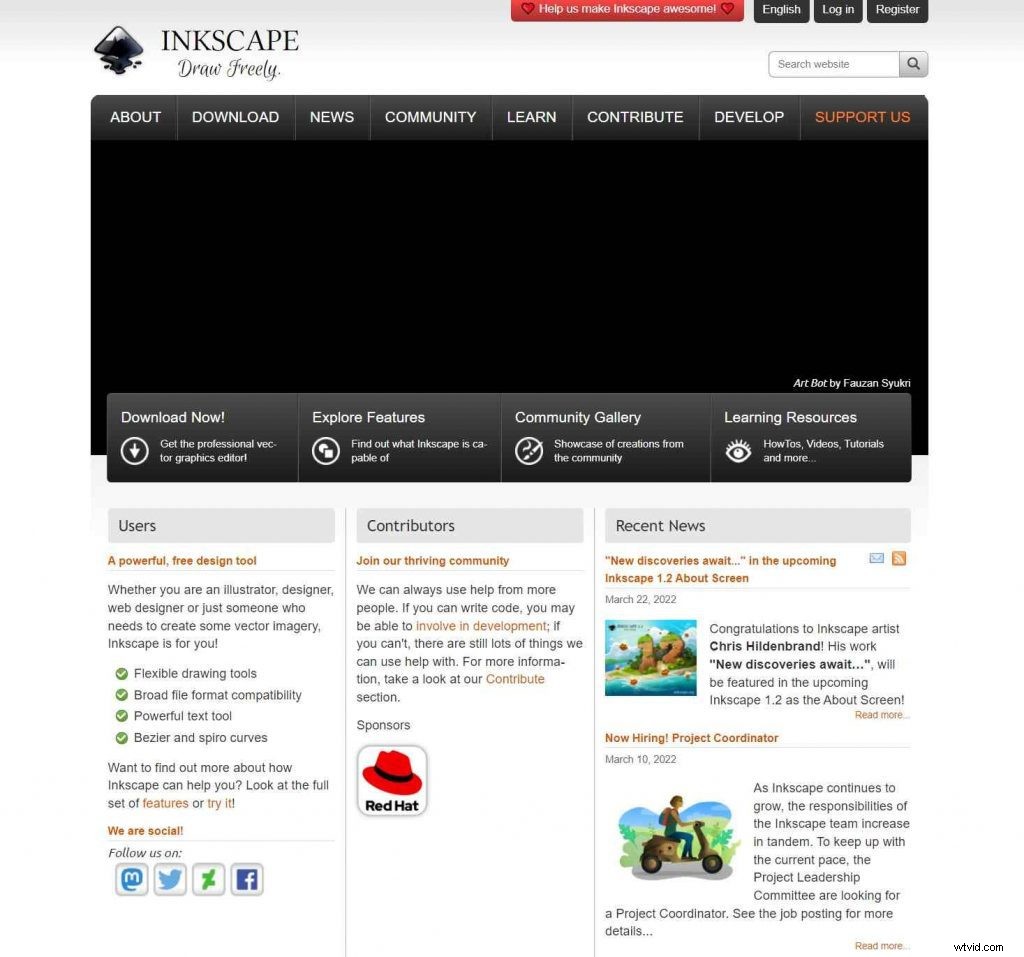
Funkcje
Funkcje Inkscape Rysowanie:Prostokąty, elipsy/okręgi, gwiazdy i wielokąty, spirale, pola 3D i nie tylko Edytowanie:Narzędzie do tworzenia węzłów do precyzyjnej kontroli kształtów, krzywych Beziera i spiro Interaktywne suwaki do szybkiego dostosowywania właściwości obiektów edycja kształtu. Pióro Beziera do tworzenia i edycji ścieżek.
Obsługa tekstu:tekst wielowierszowy, pełna edycja na płótnie, sprawdzanie pisowni. Tekst w kształcie Czcionki i tekst SVG:Pełna obsługa SVG 1.1 dla czcionek i tekstu, który można przeszukiwać i skalować do dowolnego rozmiaru bez utraty jakości Obrazy bitmapowe można importować i konwertować na ścieżki. Osadzone mapy bitowe można eksportować do formatu PNG lub innych, zachowując rysunek wektorowy.
Polecenia Wyrównaj i rozłóż:Wyrównaj wybrane obiekty względem siebie lub strony. Rozmieść odstępy między wybranymi obiektami automatycznie lub ręcznie. Transformacje:skalowanie, obracanie, pochylanie, zmiana rozmiaru, lustro itp.
Skalowanie nierównomierne (przekształcenie swobodne) z opcjonalnym ograniczeniem siatki. Klon perspektywiczny przekształca operacje na ścieżce logicznej na kształtach:suma, różnica, przecięcie itp. Łącz kształty za pomocą interaktywnych narzędzi lub operacji na ścieżce logicznej
Zalety
Inkscape Plusy Inkscape to edytor grafiki wektorowej typu open source podobny do Adobe Illustrator, Corel Draw, Freehand lub Xara X. To, co wyróżnia Inkscape, to użycie Scalable Vector Graphics (SVG), otwartego standardu W3C opartego na XML, jako format natywny.
Najważniejsze cechy to:
* Śledź obrazy bitmapowe do edytowalnych wektorów Obsługa wielu zaawansowanych funkcji SVG (markery, klony, mieszanie alfa itp.) Przekształcenia dokumentów (obracanie, skalowanie itp.) Narzędzie tekstowe z pełną edycją na płótnie oraz łatwą obsługą liter i tekstu ciągłego
* Osadzone mapy bitowe Pełna obsługa kanału alfa dla łatwej integracji z przepływem pracy w fotografii Gradienty wzdłuż ścieżek i w poprzek pociągnięć Potężny system wzorów, w tym obsługa klonowania obiektów i możliwość określania wzorów na podstawie koloru w gradiencie.
* Elastyczne narzędzia do rysowania, w tym krzywe Beziera i Spiro Rozbudowane możliwości edycji ścieżek, w tym edycja węzłów i możliwość konwersji dowolnej ścieżki na ścieżkę Beziera lub bezpośredniej manipulacji segmentami bez uprzedniej konwersji na węzły.
6. Szkic
Uwielbiam szkic. To zdecydowanie moje ulubione narzędzie do projektowania interfejsu użytkownika. Chociaż używam go dopiero od kilku lat, nie wyobrażam sobie powrotu do Photoshopa. Najlepsze jest to, że dzięki temu jestem bardziej wydajny i oszczędzam mnóstwo czasu.
Sketch całkowicie zmienił sposób, w jaki podchodzę do projektowania interfejsu użytkownika. Pierwszą rzeczą, którą robię rozpoczynając nowy projekt, jest wybór układu, a następnie stworzenie podstawowej struktury z ramkami i tekstem. Robiąc to, dowiaduję się również, ile warstw potrzebuję i grupuję je w folderach, takich jak Nagłówek, Stopka itp. Dzięki Sketchowi jest to tak łatwe i intuicyjne, że jest to prawie zabawne!
Zwykle zaczynam od modeli szkieletowych, ponieważ pomaga mi to skupić się na strukturze treści bez rozpraszania się innymi szczegółami, takimi jak kolory lub czcionki. Po utworzeniu makiet dodaję wszystkie elementy wizualne, takie jak przyciski i ikony, które są dostarczane przez sam Sketch (lub pobierane z Noun Project).
Następna w kolejce jest decydowanie o palecie kolorów i typografii. Po raz kolejny używam wbudowanych narzędzi Sketch, aby utworzyć listę wszystkich możliwych kombinacji kolorów, zanim wybiorę jeden jako mój główny motyw.
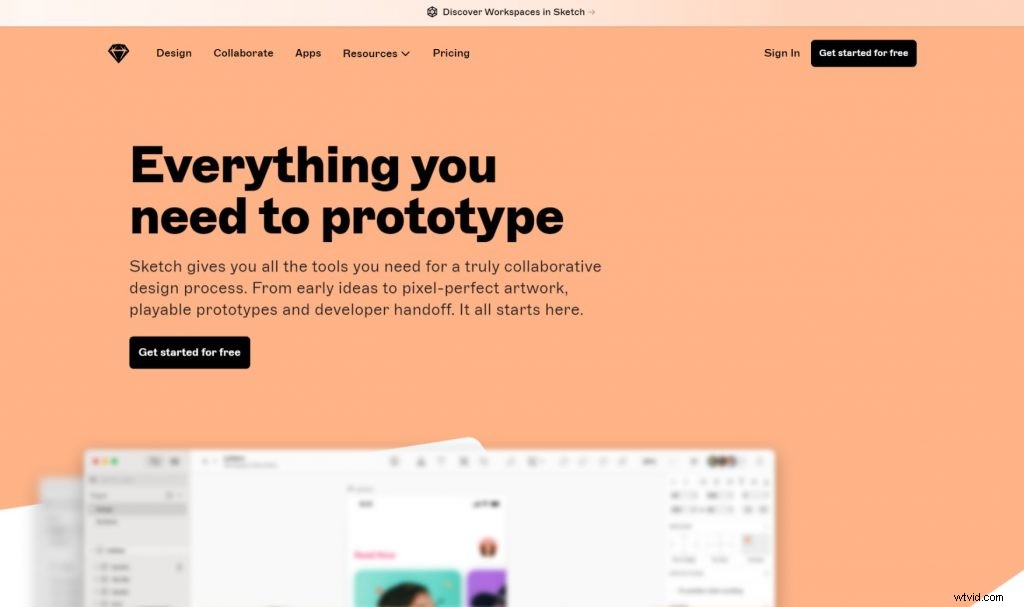
Funkcje
Sketch to zestaw narzędzi do projektowania, który pomaga tworzyć najlepsze prace — od najwcześniejszych pomysłów po ostateczną grafikę. Operacje logiczne Połącz podstawowe kształty, aby tworzyć złożone kształty za pomocą operacji logicznych.
Możesz także wycinać i dzielić kształty. Edycja wektorowa Twórz piękne, złożone kształty dzięki naszym zaawansowanym operacjom wektorowym i ustawieniom reguł nawijania. Funkcje Smart Distribute i Layout ułatwiają rozmieszczanie wielu obiektów. Eksport SVG
Generuj kompaktowy, przejrzysty kod SVG, który możesz kopiować i wklejać bezpośrednio do swoich projektów internetowych. Skorzystaj z potężnych opcji eksportu Sketch, aby wyeksportować swoje projekty w rozmiarach 1x, 2x lub 3x, jako pliki PNG, TIFF lub JPG, w czerni i bieli lub kolorze, w dowolnej rozdzielczości.
Zalety
Poznaj specjalistów od szkiców. Ich zespół ekspertów i projektantów Sketch pomaga przeglądać projekty i przedstawiać sugestie. Jeśli jesteś gotowy, aby przenieść swoje umiejętności projektowe na wyższy poziom, Sketch Pros mogą Ci pomóc. Nasz zespół projektantów posiada wysokie umiejętności w zakresie szkicowania i jest gotowy do pomocy w stworzeniu bardziej wyrafinowanego projektu, który świetnie wygląda na każdym ekranie.
Uzyskaj profesjonalną recenzję
Sketch Pros przejmą Twój projekt, ulepszą go w oparciu o najlepsze praktyki dla urządzeń mobilnych lub internetowych i przekażą informacje zwrotne na temat obszarów wymagających ulepszeń. Może to obejmować sugestie dotyczące układu, typografii, użycia kolorów, ikon, odstępów i nie tylko.
Jak to działa
Prześlij swój projekt Skorzystaj z naszego bezpiecznego formularza przesyłania, aby przesłać plik szkicu (przejrzymy również pliki z wcześniejszych wersji). Przekażesz nam również informacje o swoim projekcie i celach do przeglądu. Podamy szacunkowy czas wymagany do weryfikacji profesjonalnej na podstawie informacji, które nam przekażesz.
7. Krita
Fundacja Krita
Fundacja Krita to grupa artystów, koderów i entuzjastów, którzy pracują razem, aby wspierać rozwój Krity. Została założona w 2007 roku i od tego czasu fundacja przeprowadziła kilka udanych zbiórek pieniędzy.
Najnowsza zbiórka pieniędzy rozpoczęła się w styczniu 2017 r. w celu sfinansowania rozwoju Krity 3.1 i jej funkcji animacyjnych.
Co sprawia, że Krita jest wyjątkowa? Krita jest używana codziennie przez artystów na całym świecie, w tym profesjonalistów, studentów, ilustratorów, twórców komiksów, malarzy matowych i artystów tekstur. Krita to projekt oparty na społeczności; wspieramy potrzeby wielu artystów w zakresie wolności wypowiedzi i dążymy do tego, aby być przyjaznym domem dla artystów online.
Krita obsługuje otwarte standardy:.ora. PSD, PNG, TIFF i inne. Posiadamy również własny format pliku (krita), który pozwala zachować pełną informację o obrazie wraz z samym plikiem. Krita to darmowe oprogramowanie, więcej szczegółów znajdziesz w naszej licencji.
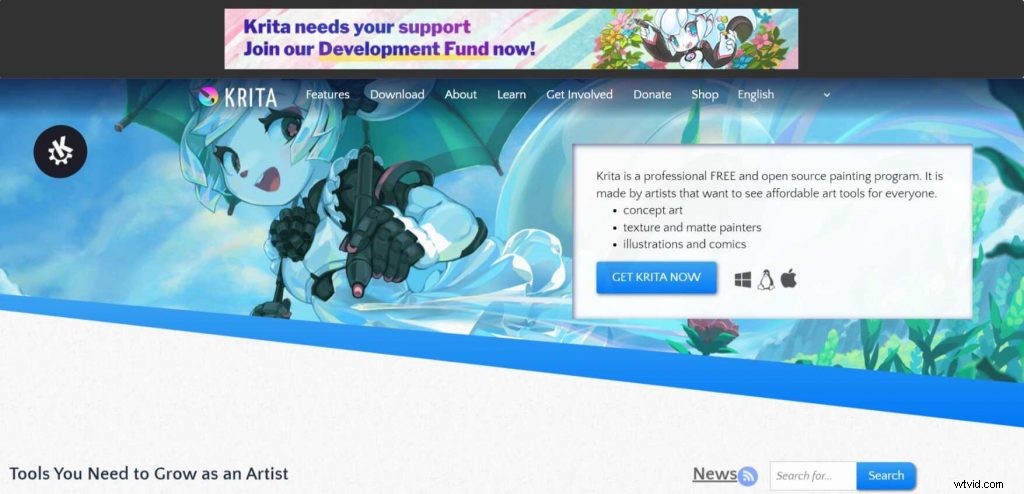
Funkcje
Krita to profesjonalny darmowy program do malowania o otwartym kodzie źródłowym. Tworzą go artyści, którzy chcą zobaczyć niedrogie narzędzia artystyczne dla każdego. grafika koncepcyjna, malowanie matowe, ilustracje, komiksy i manga
Wszystkie narzędzia potrzebne do tworzenia profesjonalnej pracy na wyciągnięcie ręki. Krita ma ponad 100 ustawień pędzla zaprojektowanych przez artystów gotowych do wyjęcia z pudełka. Twórz własne pędzle i używaj ich z tabletem wrażliwym na nacisk.
Pełny zestaw opcji warstw:a także maski wyboru, maski warstw, zarządzanie kolorami i warstwy grupowe. Płynne i responsywne obracanie i powiększanie płótna umożliwia łatwą edycję na poziomie pikseli. Użyj obrazów referencyjnych, aby pomóc w prowadzeniu kompozycji Funkcje animacji, w tym animacja rastrowa klatka po klatce, skórki cebuli, osie czasu i klatki kluczowe.
Zalety
Krita Pros Obszerny zestaw pędzli, których możesz użyć do swoich projektów Daje Ci szeroką gamę pędzli, z których każdy ma swoje unikalne cechy i specjalne właściwości. Możesz nawet stworzyć własne pędzle, jeśli chcesz! Idealne narzędzie dla twórców komiksów, którzy chcą szybko naszkicować swoje pomysły, a następnie narysować je cyfrowo.
Umożliwia umieszczenie wielu stron w jednym dokumencie, co jest bardzo przydatne, jeśli tworzysz komiks internetowy lub drukowany. Ma wbudowany menedżer ramek, który pozwala łatwo organizować wszystkie strony.
Możesz importować i eksportować pliki z innych edytorów obrazów, takich jak Photoshop lub GIMP. Ułatwia to współpracę z innymi przy projektach lub po prostu udostępnianie niektórych obrazów między aplikacjami!
Minusy:
ma stromą krzywą uczenia się w porównaniu z innymi programami do malowania typu open source, takimi jak MyPaint lub Krita; potrzeba czasu i praktyki, zanim stanie się biegły w tym programie!
7. Projektant powinowactwa
Affinity Designer to edytor grafiki wektorowej i aplikacja DTP opracowana przez Serif dla systemów macOS, iOS, Windows i Android. Została pierwotnie uruchomiona w 2014 roku jako aplikacja ekskluzywna dla systemu Mac OS X, zanim została przeniesiona do systemu Microsoft Windows w 2016 roku.
Affinity Designer został ogłoszony 18 lipca 2014 r. na konferencji Apple Worldwide Developers Conference (WWDC) dla systemu macOS. Publiczna beta została wydana 24 września tego roku. Oprogramowanie zdobyło nagrodę Apple Design Award na WWDC 2015. Zostało przeniesione do systemu Microsoft Windows w kwietniu 2016 r.
a następnie porty dla iPada i iPhone'a w tym samym roku. Publiczna wersja beta wersji na urządzenia z systemem Android została wydana w styczniu 2018 r., a pełna wersja została wydana w maju 2019 r.
Affinity Designer to edytor grafiki wektorowej opracowany przez Serif dla systemów macOS, Windows i iOS. Przed premierą nazywał się Project Gemini i został oficjalnie wydany 15 października 2014 r.
Affinity Designer to najszybsze, najpłynniejsze i najbardziej precyzyjne oprogramowanie do projektowania grafiki wektorowej. Niezależnie od tego, czy pracujesz nad brandingiem, grafikami koncepcyjnymi, projektami drukowanymi, ikonami, interfejsem użytkownika, UX czy makietami internetowymi, Affinity Designer zrewolucjonizuje Twój sposób pracy na macOS i Windows.
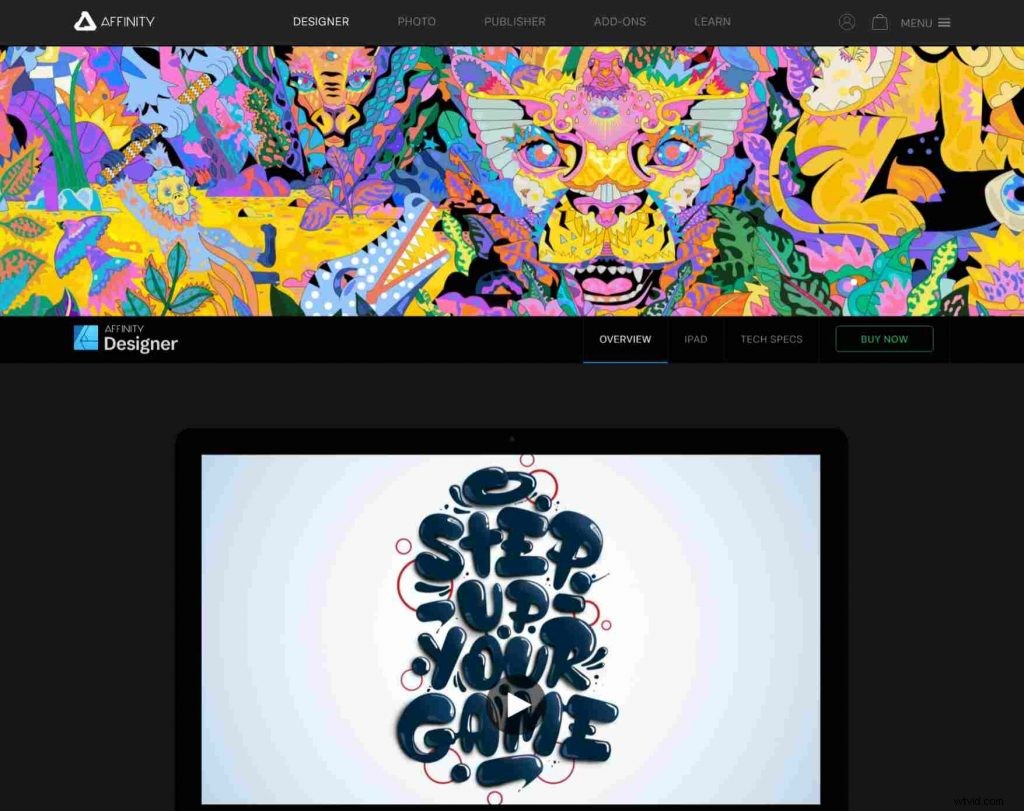
Funkcje
Affinity Designer to narzędzie do projektowania wektorów, które pozwala z łatwością tworzyć piękną, profesjonalną grafikę. Posiada wszystkie narzędzia i funkcje potrzebne do wykonywania wysokiej jakości, wysokiej jakości pracy, pozostając jednocześnie szybkim i łatwym w użyciu.
Elastyczny, konfigurowalny interfejs Affinity Designer zapewnia idealne środowisko do pracy nad dowolnym projektem graficznym. Ma łatwy w użyciu (ale potężny) obszar roboczy z wieloma obszarami roboczymi, siatkami, linijkami i prowadnicami.
Obsługuje nieograniczoną liczbę warstw, dzięki czemu możesz uporządkować swoje projekty lub importować pliki Photoshop PSD o rozmiarze do 600 MB. Interfejs użytkownika można dostosować, dzięki czemu można przełączać się między trybami ciemnymi i jasnymi oraz zmieniać układ paneli, aby dopasować je do przepływu pracy.
Zawiera również wbudowany menedżer czcionek z tysiącami czcionek, które można wyświetlić przed ich zainstalowaniem.
Zalety
Affinity Designer to edytor grafiki wektorowej i oprogramowanie do projektowania opracowane przez firmę Serif z siedzibą w Nottingham. Według wydawcy jest to alternatywa dla Adobe Illustrator, Inkscape lub Xara Xtreme.
Wersja komputerowa jest dostępna dla macOS i Windows. Wersja na iOS została wydana w 2015 roku. Wersja na Androida została ogłoszona i powinna zostać wydana w 2017 roku.
Oprogramowanie zostało początkowo uruchomione na Kickstarterze 10 października 2013 r. jako profesjonalna aplikacja do projektowania graficznego na iPada i zostało pomyślnie sfinansowane przez prawie 4500 osób wspierających z łączną kwotą 74 000 funtów. Ograniczona liczba nabywców wczesnego dostępu mogła kupić go w Mac App Store w dniu 20 maja 2014 r., przed jego oficjalną premierą 16 lipca 2014 r.
Wersja dla systemu Windows została uruchomiona 14 grudnia 2015 r. dla Microsoft Store i Steam Store. Wszedł do testów beta w listopadzie 2015 r.
8. GIMP
GIMP (GNU Image Manipulation Program) to darmowy edytor graficzny typu open source. Często jest porównywany do Photoshopa, ale jest darmowy i open source.
GIMP oferuje szereg narzędzi, których możesz użyć do manipulowania obrazami. Możesz dostosować jasność i kontrast, a nawet dokonać dramatycznych zmian kolorów.
Możesz sklonować części obrazu i wkleić je w innym miejscu, jako nowe warstwy lub w ich oryginalnej lokalizacji. Możesz także użyć narzędzi do przekształcania, aby skalować, odwracać lub obracać obrazy.
Liczne są również filtry i efekty w GIMP-ie. Chcesz zamazać część obrazu? Jest na to filtr. Chcesz dodać tekst? Na to też jest narzędzie. Chcesz stworzyć stylizowany tekst? GIMP ma również do tego filtry.
Jedną z najlepszych rzeczy w GIMP jest jego rozszerzalność. Jeśli szukasz czegoś, czego nie możesz znaleźć we wbudowanych narzędziach i filtrach, możesz przejrzeć ogromną bibliotekę wtyczek stworzoną przez społeczność na gimp.org lub przeszukać tysiące skryptów na register.gimp. organizacja
Funkcje
GIMP 2.10.0 to nowa główna wersja z ogromną liczbą ulepszeń, ulepszeń i poprawek błędów. Oto niektóre z najważniejszych cech:Kilka ulepszeń trybu pojedynczego okna Podgląd na płótnie dla filtrów Edycja gradientu na płótnie, ulepszone narzędzia do przekształcania i narzędzia do zaznaczania.
Obsługa zarządzania kolorami Ulepszone narzędzie tekstowe i renderowanie tekstu Przeprojektowany zestaw narzędzi i nie tylko.
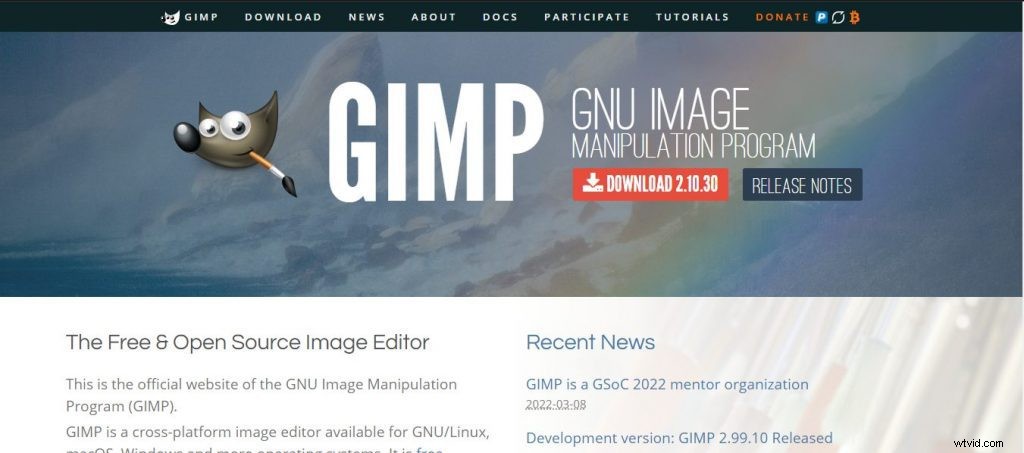
Zalety
Wszyscy używamy GIMP-a. Oto kilka naprawdę świetnych samouczków GIMP, które okazały się bardzo pomocne.
Utwórz Angry Bird w samouczku GIMP GIMP o tym, jak stworzyć fajnie wyglądający zły ptak za pomocą GIMP. Ten samouczek wykorzystuje proste techniki i powinien być łatwy do naśladowania.
Zrób prosty efekt machania twarzą w GIMP-ie Jest to krótki samouczek na temat tworzenia prostego efektu machnięcia twarzą w darmowym oprogramowaniu do edycji obrazów GIMP. Zrobimy dwa zdjęcia, jedno przedstawiające osobę, a drugie zdjęcie krajobrazowe, i przekształcimy je w zdjęcie krajobrazowe.
Jak pokolorować czarno-białe zdjęcia w GIMP 2.8 Jak dodać kolor (kolorować) do czarno-białych zdjęć za pomocą bezpłatnego oprogramowania typu open source znanego jako GIMP 2.8 lub nowszy.
Ponieważ ten samouczek jest przeznaczony dla początkujących, będziemy pracować z kilkoma podstawowymi narzędziami, takimi jak pędzel, narzędzie do wypełniania wiader, narzędzie do wypełniania gradientem i narzędzie do rozmazywania.
9. Xara Designer Pro X
Xara Designer Pro X10 to najszybsze na świecie oprogramowanie graficzne, z naprawdę elastycznymi narzędziami do ilustracji i rewolucyjną obsługą zdjęć. Designer Pro X10 to wszechstronny, szybki i elastyczny program graficzny do wszystkich potrzeb związanych z rysowaniem, edycją zdjęć i układem strony.
Xara Designer Pro X10 zapewnia wszystkie narzędzia potrzebne do projektowania świetnie wyglądających dokumentów, niezależnie od tego, czy jesteś doświadczonym projektantem, czy dopiero zaczynasz. Import your own photos or illustrations or choose from our extensive free clipart library.
Then use the powerful vector illustration tools to make your own drawings or add special effects to your text and graphics. You can also lay out your text, add tables and create a variety of different styles of columns. And when you’re done you can easily publish it as PDF, JPG, PNG or even directly upload the results to your website!
Xara Designer Pro X is the perfect choice for professional design work, ideal for both print and the web. It’s equally flexible with vector or bitmap graphics, making it perfect for any design that combines drawing, photos and text – from simple button or logo designs to incredibly detailed illustrations, posters, multi-page brochures and photo layouts.
Funkcje
Xara Designer Pro X is our top of the range product and includes all the features and templates of Web Designer Premium, Photo &Graphic Designer and Page &Layout Designer in a fully integrated single package solution for all your graphic design needs, for print and the web.
One easy to use application for all your design needs – photoshopping, illustration, DTP and document creation. Full set of graphics tools including photo handling, DTP, website creation and vector drawing.
All the features you need from a professional design software – powerful yet easy to use. Unbeatable file compatibility – import and export a wide range of file formats including Photoshop PSD files.
Zalety
- Xara Designer Pro X Pros Xara Designer Pro X is an incredibly versatile and powerful product for all your graphic design needs, for print and the web:illustration, photo editing, DTP, web graphics and websites, all in one tightly integrated suite of applications.
Easy to use:
-Works with both bitmaps &vectors
-Easy drag and drop editing
-Sophisticated text handling
-Image enhancement &more!
10. Gravit Designer
Gravit Designer is a full-featured vector design app right at your fingertip. It’s an elegant and powerful tool for creating everything from static graphics to animations, interactive designs and illustrations.
Gravit Designer delivers speed, precision, and stability and runs on all major platforms. Gravit Designer started as an in-house tool for our own projects back in the early 2000s, which we have then decided to share with the public.
Gravit Designer is a free full-featured vector graphic design app that works on ALL platforms. Unlock the full power of your creativity with fast and flexible tools tailored to professional designers.
Gravit Designer delivers a full vector toolkit for creating everything from web icons and product packaging to book illustrations and billboards. Designed for professional designers, Gravit Designer Pro gives you the freedom to design and save unlimited work, access additional Cloud storage, export assets in multiple high-resolution formats and much more.
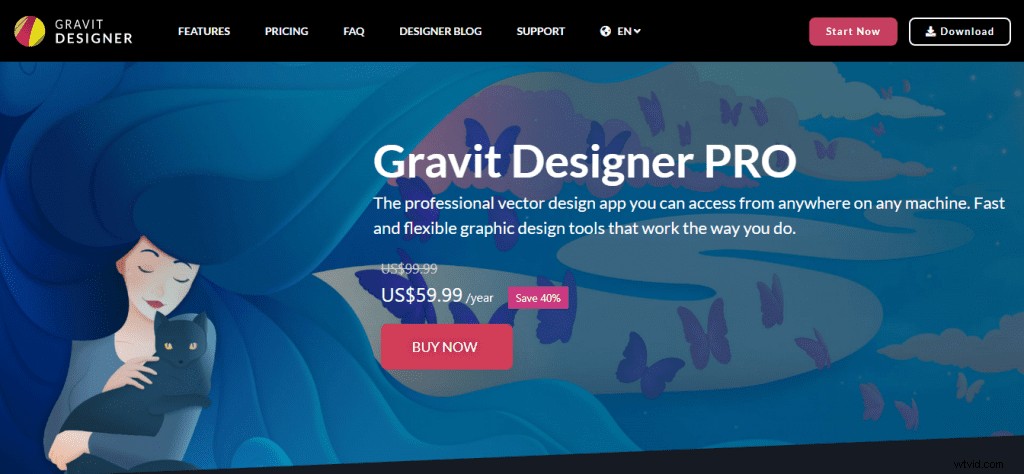
Funkcje
Gravit Designer is a fantastic, free design tool that can be used for everything from designing single page designs to creating entire branding systems. Gravit is available on Windows, Mac OSX, Linux and Chrome OS. There is also an online edition and mobile apps for iOS and Android (although the mobile apps are not quite as powerful as the desktop version).
Gravit Designer Features:Vector editing:full vector-based editing with Bezigon tool, path operations and Boolean operations; Design tools:create custom grids or use guides to align shapes; Text features:all fonts from Google Fonts included in the application;
Color picker:RGB and HSB color modes, palettes and swatches; Image effects:Gaussian blur, drop shadow, gradient overlay, color overlay and more; Export options:export to SVG, JPEG or PNG file formats; Web export option:turn your designs into interactive web pages;
Zalety
Gravit is a professional-level, cross-platform design tool that can be used on Windows, Mac OS, Linux, and Chrome OS. It’s currently available as a downloadable application or you can use the web version.
Gravit Designer Pros
- Supported by a full ecosystem of tools and plugins
- Powerful vector tools to create just about any shape you need
- Multi-platform support with offline access
Gravit Designer Cons
- No mobile apps to work on the go
- Not a great tool for photo editing
11. Photoscape
I made a name for myself as the guy who could fix your pictures. Friends, family and coworkers would come to me with their precious images, knowing that I would turn them into something they could proudly display.
But it was an annoying process that involved Photoshop, my desktop computer and a lot of time. Then I discovered Photoscape. This free photo editing program from South Korea is perfect for the home user.
It has all the features you need to organize and edit photos, including:Editing:You can crop, sharpen, remove red-eye, straighten and add frames to your photos. Batch editing:If you have multiple photos with one problem (such as red-eye or a color tint), you can fix them all at once with batch editing. Photo merging:Combine several photos into one image.
You can make a “photo sandwich” by combining two images vertically or horizontally, or create a mosaic by mixing dozens of smaller images together into one big photo. GIF animation:Make animated GIFs out of your photos or video clips. Printing:Print multiple photos on one page
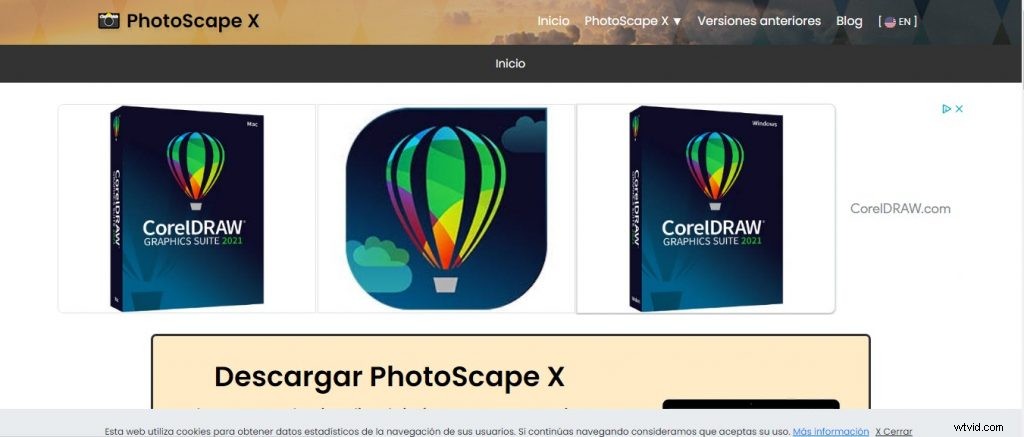
Funkcje
Photoscape is an easy-to-use and fun photo editing software that enables you to fix and enhance photos. To install Photoscape 3.7 on your computer, click one of the Free Download buttons below. Viewer:View photos in your folder, create a slideshow.
* Editor:resizing, brightness and color adjustment, white balance, backlight correction, frames, balloons, mosaic mode, adding text, drawing pictures, cropping, filters, red eye removal, blooming
* Batch editor:Batch edit multiple photos Page:Merge multiple photos on the page frame to create one final photo Combine:Attach multiple photos vertically or horizontally to create one final photo.
* Animated GIF:Use multiple photos to create a final animated photo Print:Print portrait shots, carte de visites(CDV), passport photos Splitter:Slice a photo into several pieces* Screen Capture:Capture your screenshot and save it.
Zalety
Photoscape Pros is a Photo Editing Software for Windows. It is a light weight program to edit photos and create animated GIFs. It has many useful features that you will love. Some of them are as follows:
* Provided with filters and effects to enhance your photos. You can adjust brightness, contrast, level, RGB curve and hue/saturation of the pictures. It allows you to rotate, resize, crop and rename multiple images at the same time
* You can insert text in images. You can use clone stamp tool to remove unwanted image element or blemishes in an image.
12. Genially
Genially, a Spanish company based in Barcelona, is all about empowering people to share their stories in a fun and creative way, through innovative digital experiences. But what exactly are those experiences? You can create infographics, interactive presentations, maps, surveys and much more.
Think of it as a digital canvas that you can use to express your ideas. What’s important is that these experiences are web-friendly and you can share them in any platform or device.
So whether you want to share them on your website, in your newsletter, or even on social media like Facebook or Twitter, now you can present your visual content in a new way. On top of that, Genially offers an analytics dashboard so you can track who is interacting with your content and where they are located.
But let’s not get too technical! It’s time to start creating! To get going with Genially, head over to our templates gallery to access the different categories we have available:infographics and data visualization; travel; education; business; social networks; and retail &ecommerce.
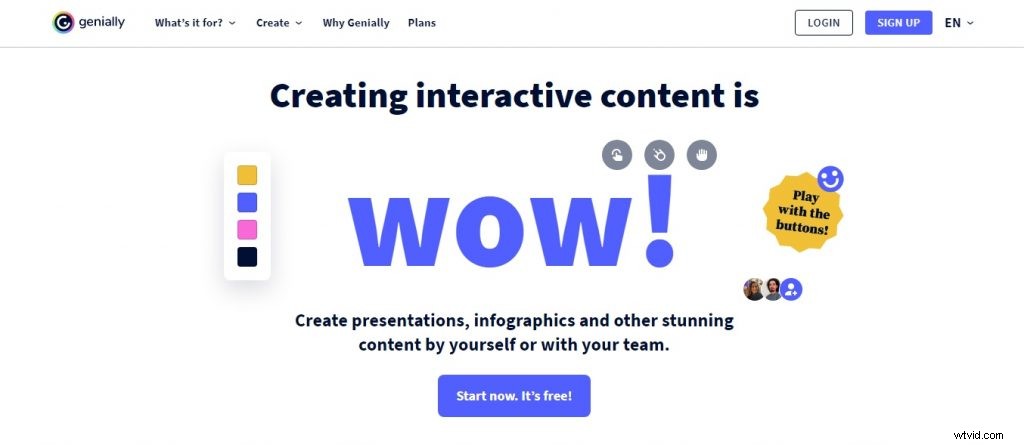
Funkcje
Genially is a creative tool designed to make your presentations, infographics and interactives more eye-catching and memorable. Genially is different because it enables you to create content that’s much more dynamic than a classic presentation.
You can add animation, transitions, online videos, maps, images or GIFs to bring your content to life. You can also add links to pages within the same genially or external webpages so that your viewers can explore the topic in further detail.
Let’s take a look at some Genially features! All you need is an Internet connection and an account on Genially (it’s free!) to use these tools.
Zalety
Genially Pros is a team of experts in design, marketing, communication and education. They are the ones who will help you create the most fascinating geniallys.
More than 20 professionals specialized in different areas make up our team:Communication, Education, Marketing, Design and Business Development. They will support you to create your projects from their experience and knowledge in their respective fields.
In addition, they can also train you so that you can later develop them independently.
13. Vectr
Vectr is a free graphics editor used to create vector graphics easily and intuitively. It’s a simple yet powerful web and desktop cross-platform tool to bring your designs into reality.
With Vectr you can:Create, edit, and export vector images for logos, icons, user interfaces, print media, animation, game assets, etc. Don’t worry about file formats ever again. Your projects can be exported as high-quality PNGs or SVGs for web use or PDFs for print.
Collaborate in real-time with your team whether you’re on Mac, Windows, or Linux. Vectr is a free graphics software used to create vector graphics easily and intuitively. It’s a simple et powerful web and desktop cross-platform tool to bring your designs into reality.
Getting Started Vectr’s basic graphics editor is free forever. It works on Mac, Windows, and Linux, and comes with versatile features such as a tool for creating icons, mobile widgets, styled text, and much more. You can use it online or download the desktop version.
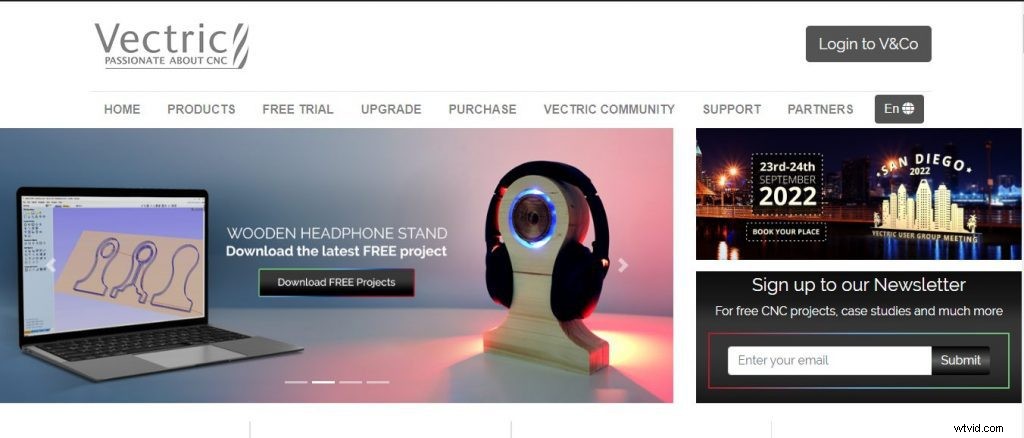
Create vectors in real-time Vectr’s intuitive tools let you focus on what truly matters – creating beautiful graphic designs. Start designing now!
Funkcje
Vectr is a free graphics software used to create vector graphics easily and intuitively. It’s a simple yet powerful web and desktop cross-platform tool to bring your designs into reality.
Here are some of the Vectr features:Use our Desktop app for Mac and PC Access your work whenever you need it. Download for Mac or Windows.
Work offline on your Desktop No Internet connection? No problem! You can work offline with Vectr on your Desktop and pick up right where you left off when you’re online again. Share your visuals online in seconds Publishing and sharing projects is a click away.
Share links with your team, clients, friends, or family so they can view and collaborate in real-time. Easily share on social media platforms like Facebook and Twitter from within the app.
Zalety
Vectr Pros are the most dedicated and passionate users of Vectr. They are designers, developers, and startup founders who have been with us since the beginning.
You can recognize a Pro user by their purple badge on their profile picture. Pro users can join our exclusive weekly Pro Hangouts with the Vectr team.
We’ll discuss new features, ask for feedback, and answer your questions. Here’s what you get when you upgrade to Pro:See who’s viewed your projects Create unlimited projects Unlimited project collaborators Access to all premium templates and fonts (coming soon).
What Are the Benefits of Graphic Design Software?
- The Benefits of Graphic Design Software:If you are looking for a job in graphic design, then you are going to need to get some graphic design software. Fortunately, there are many options available for you, no matter what your budget is.
- You may want to start out with free programs and then move on to more expensive ones as your skills improve.Here are the top reasons why it is important to have graphic design software:
- Efficiency – Graphic design software can help increase your productivity. Instead of spending hours using a traditional drawing program, you can create professional-looking documents with just a few clicks of the mouse.
- Affordability – Because so many people are starting their own businesses these days, they often find themselves having to choose between buying expensive equipment and spending money on advertising and marketing. With so many options available, there is no reason why anyone should have to settle for an amateurish product.
- Ease of use – Most people find that using graphic design software is easy and intuitive. With the right program, even beginners can create beautiful designs quickly and easily. There is no need for extensive training or experience in order to use these programs.
1. Benefits of Graphic Design Software Flexibility and Scalability
There are many benefits of graphic design software. From design management to project management, it can be used to optimize a number of tasks that are necessary for business success. However, the most important benefit it provides is flexibility and scalability.
The Benefits of Graphic Design Software Flexibility and Scalability Flexibility Graphic design software is flexible in that it allows you to utilize a variety of different tools in order to create the best possible designs for your business. Whether you are creating digital advertisements or flyers for print, there are tools that provide the flexibility you need to achieve your goals.
This is especially important if you have multiple different platforms which you use in order to advertise your business. Additionally, if you have multiple people working on your designs, graphic design software gives them the ability to collaborate on one project.
This ensures that everyone understands what needs to be accomplished and how they can contribute to achieving those goals. This takes the burden off a few individuals and instead makes it possible for multiple people to work together towards common goals.
Scalability
Graphic design software also offers scalability as another benefit. Scalability refers to the ability of your program to build upon itself and address new needs as they arise. As your business grows, so too will the need
2. Benefits of Graphic Design Software Cost Efficient
Graphic design software is a computer application used to create and edit visual content. It is available in many versions and formats, ranging from very simple to extremely complex.
Graphic design software can be used by professional graphic designers or by individuals who want to create their own designs. Graphic design software is a tool that allows designers to easily create complex designs without having to know how to write code or use complicated graphic techniques.
This type of software is used by people who work in graphic design, advertising, or any other field where they need to create images for a website or other media. Benefits of Graphic Design Software Cost Efficient Graphic design software is usually much less expensive than other types of graphics programs.
This makes it easier for people who want to learn the basics of graphics but don’t want to spend too much money on expensive programs. Some graphic design software even comes with free tutorials that can help beginners learn the basics quickly.
Easy To Use
The interface of graphic design software is usually very simple and easy to use, which makes it easy for beginners to get started with it. The user interface is usually also very intuitive and user friendly, which means that anyone can use it without having to have any experience in graphic design at all.
3. Benefits of Graphic Design Software Branding
The graphic design industry is constantly changing. Technology plays a key role in the creation of new trends and artists are always looking for new ways to present their work. To this purpose, graphic designers use all sorts of tools to get the job done.
As an artist, you are no longer limited by any restrictions when it comes to creating your work. All you need is access to a computer and the internet, and you can download various programs that can help you create your graphics. In this article we’ll take a look at some of the benefits of using graphic design software to create your work.
Here are 6 Benefits of Graphic Design Software Branding!
1-It allows you access to thousands of templates that can be used as a starting point for your designs. You’ll have access to hundreds of fonts, colors and shapes that can be used to create something unique.
3-There’s no need to worry about copyright infringement or plagiarism because all the images are royalty free. You’ll have full control over what goes into your design and how it looks like without having to worry about other people’s rights being infringed upon.
4-You’ll also have access to millions of images from different sources which means there’s always something available for whatever idea
4. Benefits of Graphic Design Software Increased Engagement
Benefits of Graphic Design Software Increased Engagement Graphic design is a medium of communication that utilizes images, words and other visual elements to convey ideas or messages. For example, if you are trying to teach a class about the different types of animals living in the jungle, you can use graphic design to create posters that feature each animal along with their picture, name and some interesting facts about them.
This is a quick and easy way to convey information to your students without having to write it down on paper.Benefits of Graphic Design Software Increased Engagement Graphic design software is used by professional designers who want to create original artwork for various purposes.
Some of these artists use traditional drawing techniques while others rely on vector graphics programs and other advanced technologies. In addition, there are many different graphic design software packages available online that allow beginners and professionals alike to create stunning designs without spending too much money.
There are several benefits offered by graphic design software that can help you improve your skills as well as increase your business’s profitability.
5. Benefits of Graphic Design Software Time-Saving
Time-Saving This is one of the best benefits of graphic design software. Without the right software, creating a design is a time-consuming task that can take days to complete. With the right software, you can easily create any design in less time.
If you are designing a brand package and need to duplicate your designs for different sizes or different products, you can do so with just one click. You can also use graphic design software to create templates for future use. That way, you will only have to edit your text and save it as a new file.
Graphic design software has many other uses, such as creating logos, brochures, flyers, business cars and more. Before you purchase any graphic design software, there are several things that you should know about it.
While this may seem like an obvious statement, many people make the mistake of believing that they need to purchase expensive software in order to create professional looking designs. This is not true at all.
The Benefits of Graphic Design Software Time-Saving Graphic design software has many other uses, such as creating logos, brochures, flyers, business cards and more. Before you purchase any graphic design software, there are several things that you should know about it. While this may seem like an
6. Benefits of Graphic Design Software Minimum Human Intervention
Benefits of Graphic Design Software Minimum Human Intervention In the past, graphic design was a time-consuming and expensive process. You had to hire graphic designers and spend a lot of time with them to get the desired results.
There were also no guarantee that the designs will be up to the required standards. You can get graphic designs for your business without worrying about these challenges. All you need is a reputable graphic design software that allows you to come up with stunning designs in a matter of minutes.
In this article, we are going to look at some of the benefits of using a graphic design software as opposed to hiring human graphic designers. Minimum human intervention All you need is a good computer that has an internet connection, and you are good to go.
You do not have to create an office for the graphic designer or even meet him/her. You can just sit back in your home or office and still design some of the best graphics for your business or personal use.
This saves you a lot of time and money since you do not have to rent an office space or travel to see the designer. The only thing that you need is a software package that allows you to create some professional graphics within minutes.
7. Benefits of Graphic Design Software Custom Branding
Benefits of Graphic Design Software Custom Branding Graphic design software is a program that helps you to create images in digital format. Basically, there are two types of graphic design software available in the market. One is open source and another is proprietary.
If you are interested in creating a customized brand, you must use professional graphic design software. There are different types of software available for you to choose from. These include Adobe Photoshop, CorelDraw and many others.
The main advantage of using graphic design software is that it allows you to create your own logo and branding easily. You can easily use the tools available to create logos for your company or website
. The tools also help you to modify your existing logos as well as designs. With the help of these tools, you can also save your work online so that it can be downloaded at any time by other people or companies who want to use your designs or logos for their purposes.
Another benefit of this type of software is that it allows you to develop unique business cards and brochures for your business. You can even customize them according to your specifications and requirements so that they meet all the needs of your customers and clients in a better way. Moreover, with this type of software, you can also make changes on.
How Does Graphic Design Software Work?
Becoming a graphic designer is something that everybody wants to do. First, you have to understand what graphic design is and how it works. Graphic design is a skill that allows you to communicate your message visually.
It can be used for logos, websites, posters, brochures, business cards and more. When it comes to designing your own stuff, you will need a graphic design software tool. There are many tools available in the market, but not all of them are made equal.
If you want to become a professional graphic designer, you need the right tools first. Graphic design software is basically used for creating visual content like icons, typography and illustrations.
The best part about graphic design software is that it has some pre-defined templates for creating various designs quickly. And if you want to create something from scratch, it also has all the tools that you will ever need for your graphic designing needs.
Graphic Design Software Features:Although there are many features present in graphic design software tools, some of the top features are:
Vector Images:When it comes to vector graphics, they are images that are composed using basic shapes and mathematical formulas. These types of images can be scaled without losing quality and resolution. All the most popular vector editing software tools allow users
1. Graphic Design Software Create a New Document
When you open a new document in graphic design software, you’ll need to select a size for your canvas first. Make sure that your canvas is set to the correct size and has the correct resolution for your intended output.
Once you’ve selected a size for your canvas, you can begin designing within the document. You can add images and text to the canvas, as well as shapes and colors.
Many graphic design software programs also have tools that allow you to draw directly on the canvas. Once you’ve designed your image, you can save it as a JPEG or PNG file. If you want to edit it later, however, it’s best to save it in a native format for the program in which you created it.
2. Graphic Design Software Enter The Camera Raw-Panel
The concept of graphic design is far more than just a description of the profession, it is a description of the work produced. Graphic designers use various methods to create and combine words, symbols, and images to create a visual representation of ideas and messages.
The larger scale designs include such items as advertisements, signs and even computer icons, while the smaller scale designs include things like business cards, brochures, letterheads and logos.
Creative individuals who are interested in graphic design should develop their own unique style based on the principles they have learned while gaining knowledge through their own education. Graphic design is essentially an art form that combines creativity with technology to produce visually appealing works.
In order to become successful in this field, you must be able to understand your clients’ needs and translate those into an effective marketing strategy. A graphic designer can work either independently or as part of a team.
In order to succeed in this industry, it is essential that you are able to communicate with all members of your team effectively. Good communication skills are necessary in order to ensure that you are working towards your client’s goals.
If you have already decided that you want to become a graphic designer but do not have any experience yet, there are many opportunities available for people who want to gain valuable experience
3. Graphic Design Software Workspace Overview
CorelDRAW Graphics Suite is a powerful graphics tool that helps you create beautiful designs, graphics, photos, and websites with both ease and confidence. CorelDRAW Graphics Suite offers many features to help you get started quickly, including the.
New from Template dialog box, an interactive Welcome screen, workspace customization options, support for multiple monitors and a variety of document types. TZe Graphic Design Software Workspace.
When you start CorelDRAW Graphics Suite, the New from Template dialog box will open by default. You can use this dialog box to select the type of file you want to open or create. The content in the New from Template dialog box is updated monthly with new templates created by CorelDRAW team members
. Click a category in the left pane and then click an item in the right pane to view a preview of that item in the Preview window. To open an item as an existing document in CorelDRAW or as an image in PHOTO-PAINT, double-click its thumbnail.
To create a new file based on one of these templates, click the Create button at the top-right corner of the dialog box. To skip opening the New from Template dialog box when you start CorelDRAW Graphics Suite:
Click Options> Application
4. Graphic Design Software Learn The Meaning of Basic Tool Icons
If you’re new to photo editing, the first thing you need to know is that there are two categories of tools:selection and editing. Selection tools allow you to select a portion of an image while editing tools allow you change the selected portion.
To help keep track of all of these amazing apps, here’s a look at some of the most common graphic design software icons. Graphic Design Software Learn The Meaning of Basic Tool Icons Selection Tools The Marquee Tool is used to select rectangular and elliptical areas on an image.
It’s used for cropping images and selecting objects. The Lasso Tool is used to select freehand areas on an image by drawing outlines around them. It’s used for making quick selections.
The Magic Wand Tool is used to select areas based on color similarities. When this tool is clicked inside an area, the area is selected if it has similar colors as the area surrounding the pixel where it’s clicked.
It’s used for isolating objects from their backgrounds when their backgrounds have similar colors from their edges or when there are multiple objects close together with similar colors. The Crop Tool is used to select a rectangular area on an image and remove everything outside of
5. Graphic Design Software Layers, Groups, and Guide
Layers are a very important part of graphic design software. This is because they allow you to build up your design in an organized way, which makes it easy to edit and update elements in the future.
Graphic Design Software Layers, Groups, and Guide How to use layers in graphic design software A layer is basically a transparent sheet that can contain any number of objects in a design. You can add text, vector shapes, raster images, or anything else you want to each layer.
If you use layers properly, then editing or updating your design is usually pretty simple. For example, if you want to change the color of your text, you simply click on the text on the relevant layer and update it. This is a lot easier than trying to select the different parts of your text manually!
If you want to move an element in your design — say one of the icons in this template — then all you need to do is select the layer containing that icon, and drag it around until it’s exactly where you want it.
When designing with layers, always make sure that everything on each layer relates to each other somehow. If there’s no clear relationship between all the elements on a single layer then it may be better.
6. Graphic Design Software Create a Wallpaper
Graphic design is an art that requires the proper tools, and when it comes to the software, you can’t afford to go wrong. While there are basic programs for simple tasks like cropping images or editing a photograph’s brightness, more sophisticated software is required for projects that demand high-level image composition or photo manipulation.
If you’re looking for graphic design software to create your next masterpiece, here are some of the best options on the market. Adobe Photoshop. The most popular and widely used graphic design software on the market today remains Adobe Photoshop.
It’s powerful enough for just about any project you can dream up, but it also has a steep learning curve. If you’re a beginner, you may be better off starting with a simpler program and then moving up to Photoshop once you’ve mastered the basics.
GIMP. For Mac users looking to do some graphic design without breaking out the credit card, GIMP is a great option. It’s open source and free, with all the features of Photoshop except support for CMYK color mode (for those who do print work) and more limited support for 16-bit color depth files (mostly used in pro photography).
Inkscape. This vector graphics editor lets you create line drawings and
Graphic Design Software Frequently Asked Questions
- If you are looking to make a change in the type of software you use for graphic design, you may have questions about compatibility. The following are the most commonly asked questions regarding graphic design software.
- Is it easy to move between different types of software? The short answer is no. It is not easy to transition between different types of graphic design software, but it is possible.
- You may need to change how you think about certain things when using one program over another and there will be a learning curve involved in getting used to new tools and methods. What are vector graphics?
- Vector graphics are created using shapes instead of pixels. The advantage of vector graphics is that they can be scaled up or down in size without losing their resolution or quality.
- Vector graphics are created using programs such as Adobe Illustrator and CorelDraw. What is the difference between raster and vector graphics? Raster images, also called bitmap images, use pixels to form an image that can be manipulated by a photo editor or graphic design software application.
- This type of image cannot be enlarged without losing its quality and resolution. Raster images are usually used for photographs or other types of artwork that require fine detail. Vector images, on the other hand, use points that are connected by
1. What is graphic design and what does it include?
Graphic design is the process of visual communication and problem-solving through the use of typography, photography, and illustration. The field is considered a subset of visual communication and communication design, but sometimes the term “graphic design” is used interchangeably with these due to overlapping skills involved.
Graphic designers create and combine symbols, images and text to form visual representations of ideas and messages. They use typography, visual arts and page layout techniques to create visual compositions.
Common uses of graphic design include corporate design (logos and branding), editorial design (magazines, newspapers and books), wayfinding or environmental design, advertising, web design, communication design, product packaging and signage.
Graphic design is a creative process. It involves a client and designer working together to solve a problem or achieve a goal. A graphic designer is responsible for cultivating the visual appearance of websites, books, magazines, product packaging, exhibitions and more.
The role of a graphic designer isn’t overtly creative. The role of graphic designers is to interpret the client’s needs and the project’s objectives in order to come up with an original solution that will be visually appealing, on-point and appropriate.
2. What software do most graphic designers use?
Adobe Photoshop, Adobe Illustrator and Adobe InDesign are the industry standard applications for many graphic design positions. If you’re interested in web design, you’ll want to learn HTML, CSS and JavaScript.
While Photoshop, Illustrator and InDesign are the industry standard applications for many graphic design positions, there are other programs that may be relevant to your career path. Many designers use a hybrid approach of using raster based programs for editing photos or creating raster based elements and vector based programs for creating vector elements.
Here’s an overview of some common graphic design software:SoftwareDescriptionAdobe PhotoshopThe most popular image editing software. Raster based program used for photo correction and manipulation as well as for creating raster based graphicsAdobe IllustratorThe most popular vector drawing software used for creating logos, illustrations and infographics.
Adobe InDesignAdobe’s professional publishing software including layout tools similar to a word processor for creating posters, flyers etc.Adobe XDUser experience design software used to create wireframes and interactive prototypes.HTML5 &CSS3The most common coding language used to build websitesJavaScriptThe programming language used to add interactive elements on websites
3. Which Adobe graphic design software is the best?
Adobe offers several different graphic design software programs. They’re available in a Creative Cloud suite or individually. Adobe provides a comparison table on their website to help you find the right software for your needs.
Which one is best depends on what you need to do. The three most common Adobe graphic design software are Photoshop, Illustrator, and InDesign. Photoshop is primarily for photo editing, where you can create, edit and retouch images.
You can also create digital artwork from scratch by adding layers that include text, color and shapes. This software is used by both professional photographers and graphic designers. You can also save files in various formats including JPEG, TIFF, PNG and PSD to use with other Adobe products like Illustrator or InDesign
Illustrator is vector-based software that allows you to create logos, icons, sketches and typography. The files are small but high quality so they can be scaled for any size production without losing resolution.
It’s commonly used for print projects like brochures and flyers because it allows you to easily change colors and fonts. InDesign is perfect for creating large documents like magazines or online publications like PDFs, eBooks and interactive online documents (like the ones we produce at Hinge). It
4. Where is graphic design used?
Graphic design is all around us, in a myriad of forms, both on screen and in print, yet it is always made up of images and words to create a communication goal. This includes logos, branding, brochures, websites, magazines, signs and any other form of visual communication.
Graphic design is about problem-solving and about creating original relevant message for specific audiences. It requires an understanding of audience needs and the context in which a design project exists.
Graphic design can be used for advertising, or just to make a product look more attractive. Graphic designers use various methods to create and combine words, symbols, and images to create a visual representation of ideas and messages.
A graphic designer may use a combination of typography, visual arts and page layout techniques to produce a final result. Graphic design often refers to both the process (designing) by which the communication is created and the products (designs) which are generated.
5. What do graphic designers use to create these designs?
I am going to give you a list of the best programs that most designers use. These are just the basic programs that we use but there are others too. Adobe Photoshop:This is one of the main programs that all graphic designers learn to use.
If you want to get into the world of creating designs for logos, and other graphics then Photoshop is your best friend. Adobe Illustrator:This is another program that goes hand in hand with Photoshop.
Adobe Illustrator is used by designers who love to create vectors and other types of illustrations. Many designs have been created using this program alone, but like I said above, it goes hand in hand with Photoshop.
Adobe InDesign:This program is mainly used by Graphic Designers who create magazines, brochures, and books! It is also used by designers who are creating flyers, posters, and more. I’ve seen a lot of people use InDesign for their logos too!
Adobe XD:This is a relatively new program that Adobe came out with and it is great for creating prototypes and wireframes of web pages and mobile apps! It’s extremely easy to use and has many features that allow you to see what your design would look like on any device or operating system
6. What can a graphic designer do that I can’t do?
I know it can be tempting to skip hiring a professional designer. In fact, I’ve heard many clients say they have “a friend who does design” or “I can do it myself”. Before you pour hours into an online graphic design tool or reach out to your buddy who is good at Photoshop, ask yourself:What can a graphic designer do that I can’t do?
1.Your brand is more than just a logo A common misconception about hiring a graphic designer is that it’s like hiring an artist to paint a picture for you. You tell the artist what you want and then he paints it.
In reality, the process of creating a logo is so much more complex. A professional graphic designer understands how to communicate your business’ values through visual elements such as color, typography and imagery. They know how important these elements are in attracting your target audience and building trust with them. A great logo will make your brand stand out from the competition and build recognition with your customers.
7. What’s the best graphic design software for beginners?
As a beginner, you don’t need over-the-top power and functionality. All you really need is an easy-to-use interface and the ability to create great-looking designs fast. Luckily, that’s the focus of each of these three programs.
When it comes to the best graphic design software for beginners, we recommend Canva. The program is quick to learn and use, even if you’ve never done any graphic design before. It includes thousands of templates and images that you can quickly customize with its drag-and-drop editor. You’ll also get access to free photos, graphics and fonts that make it easy to create beautiful designs right away.
If you want more customization options than Canva offers, or if you prefer working on a desktop application instead of a web browser, look into CorelDRAW Essentials X8 (for Windows) or Adobe Photoshop Elements (for Windows or Mac).
Both programs cost more than Canva but offer a wider range of tools and more advanced features. They’re not as simple to learn as Canva, but they’re still easy enough for beginners to use.
8. What’s the best free alternative to Adobe Photoshop?
There are some great alternatives to Photoshop. There are also some that are not so good. Here are a few of the best options for a free Photoshop alternative:
GIMP Started in 1996, this open-source graphics editor is still going strong. It features a wide range of tools and is used by professionals as well as hobbyists.
It supports layers, masks, filters and plugins and can be used for photo editing or creating new images. You can use GIMP to edit raster graphics or convert them to vector images. It’s available for Windows, Mac OS X and Linux.
Paint.NET This image editor has been around since 2004 and started life as an undergraduate college senior design project mentored by Microsoft. Development still continues today with regular updates and fixes.
Its intuitive interface makes it easy to learn and use, but there are plenty of advanced features too, such as support for layers, blending modes, unlimited undo, special effects and much more. It’s suitable for everything from simple image retouching to complex graphics creation. To install Paint.NET you need Windows 7 or later with the .NET Framework 4.6 already installed (which is usually the case).
Krita This open source digital
9. What else does a graphic designer accomplish as part of the work they produce for a client?
A graphic designer usually works as part of a team, and is responsible for creating the visual aspects of a design project. Graphic designers work across a range of marketing and communication materials such as magazines, advertising, corporate branding and websites.
Graphic designers are skilled at developing design solutions to communicate their clients’ messages through print or electronic media. They use computer software to manipulate text and images to create visual representations of ideas and message.
Graphic design is a highly collaborative profession, which means graphic designers usually work as part of a team of other professionals who share their knowledge and skills. The team might include copywriters, photographers, illustrators, web developers, account executives, creative directors and/or other specialists. The graphic designer’s role is often to coordinate the work produced by the team in order to meet their clients’ needs.
Graphic design is a tool that helps you get more sales and make more money. It also helps you build trust with your customers and makes it easier for people to remember you. Here’s a great book about the psychology of graphic design:http://www.amazon.com/Graphic-Design-Te…
10. How can I work with a graphic designer and stay on budget?
One of the most common questions I get from my clients is, “How can I work with a graphic designer and stay on budget?” I know it’s hard to find the right designer, especially when you’re looking for someone reliable, experienced, and affordable.
Well, good news — there are some things you can do to help make sure you get a high-quality design without breaking the bank. There are several parts of every design project where you can save time and money:
- Pick a designer who has experience with your industry. A designer who knows your industry will be able to tap into their existing knowledge.
- This means they’ll have a head start on creating a design that communicates your message effectively.Pick a designer with the right software. Be aware that not all designers have access to all the latest software.
- Sometimes, if your project requires a specific piece of software, you’ll need to pay extra for it or source it yourself. To avoid this, ask potential designers whether they have access to the software you need before beginning your project together.
- Make sure you’re very clear about what you want before you start working together. Some clients come to me with very general ideas like “I want an infographic” or “
11. What’s the best graphic design software for t-shirts?
The best graphic design software for t-shirts is CorelDraw. The software is the preferred option for both professionals and beginner graphic designers.
Corel Draw is a vector graphics editor developed and marketed by Corel Corporation of Ottawa, Canada. It is also the name of Corel’s Graphics Suite, which bundles CorelDraw with bitmap-image editor Corel Photo-Paint as well as other graphics-related programs (see below).
The latest version is designated X7 (equivalent to version 17), and was released in March 2014. CorelDraw is designed to edit two-dimensional images such as logos and posters. Adobe Photoshop, on the other hand, is a raster graphics editor developed and published by Adobe Systems for macOS and Windows.
Photoshop was created in 1988 by Thomas and John Knoll. Since then, it has become the de facto industry standard in raster graphics editing, such that the word “photoshop” has become a verb as in “to Photoshop an image,” “photoshopping” and “photoshop contest”, though Adobe discourages such use. It can edit and compose raster images in multiple layers and supports masks, alpha compositing and several color models including RGB, CMYK, CIELAB
12. Which graphic design software is best for logos?
It’s not just about the software you use, but how you apply it. The best logo design software is only as good as the designer using it. You could use the worst software in the world, but if you’re a great designer, then you’ll still come out with a great design.
In saying that, I wouldn’t recommend using bad software. So which graphic design software is best for logos? I’m glad you asked! In this article, I’ll share my recommendations for the best software to use when designing logos.
- Adobe Illustrator One of my favourite tools to use when designing logos is Adobe Illustrator. It’s a vector graphics editor that allows me to create scalable logos without any loss of quality. Plus, it’s packed full of amazing features that will help you create truly outstanding logos (my favourite is the Shape Builder tool).
It’s a question that’s been asked a lot over the years, and it’s not surprising. Designers are always looking to be more efficient and effective, and using the right tools is an important part of that.
Picking the right one for the job can mean better productivity, better results and a better approach to your design work. So which one is best?
13. Which graphic design software should I use to make invitations?
It depends what you want to achieve. Adobe InDesign is a layout program, which means you can use it to place text and images and create pages that are ready for print or export as PDFs. It’s a great tool for creating anything from flyers to books.
The downside is that it has quite a high learning curve so if you only want to make invitations with it, it might be overkill. Canva is also a layout tool, but with the key difference that it’s web-based and free to use (you can buy premium images and fonts if you like).
They have lots of pre-made templates you can use, including invitations, and unlike InDesign you don’t need to be a pro designer to use it. The downside is that while they have a lot of graphics available, they’re all pre-made so might not be exactly what you’re looking for. If you’re looking for something that lets you get an invitation done quickly without the hassle of learning complicated software, Canva is a good choice.
If you just want some basic editing tools like cropping and resizing there are plenty of free options available – Paint.net is one I’ve used in the past which works well on Windows machines (though I’ve heard
14. What is the best process for working with a graphic designer?
It’s important to keep your branding consistent across all of the graphics you create. Whether you’re designing business cards, letterheads, posters, or social media graphics, your logo and brand colors should be integrated into your designs.
Otherwise, you risk diluting your brand impact and confusing your audience There are a few different ways you can approach the design process:Use a template. Many online graphic design tools come with hundreds of professionally designed templates that are easy to customize.
You don’t need to start from scratch, which will save time and effort if you’re not a professional designer. Work with an in-house designer. Small businesses might have someone on their team who’s willing to take on graphic design work in addition to their regular responsibilities.
However, hiring a full-time graphic designer can be expensive for small businesses that don’t have a lot of extra funds available for this type of expense. Hire freelance designers on Upwork.
Freelance designers can charge anywhere from $20 per hour to $100+ per hour based on experience and skill level so this is something small business owners should consider when looking at their budget.
Best Graphic Design Software – Wrap Up
You have to know what your needs are, and if you need to handle multiple design tasks with a single software application. If you’re working on branding and logo design, you might want to look into CorelDRAW Graphics Suite.
This software application has one of the industry’s best tools for logo design, and its collection of templates is top-notch. If you’re looking for website design tools, Adobe Photoshop makes a great choice.
It allows you to create site mockups at any resolution you desire, and also do things like resize images and apply effects. If your goal is to create beautiful illustrations or drawings, it’s hard to beat Affinity Designer.
It includes an extensive set of drawing tools that give your illustrations a professional look and feel. When it comes down to it, the best graphic design software is the one that meets your needs.
So before buying a product, make sure it offers the features you need to succeed.

